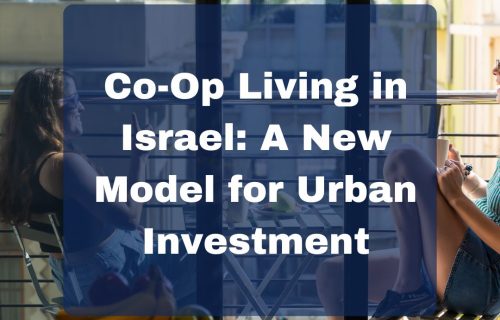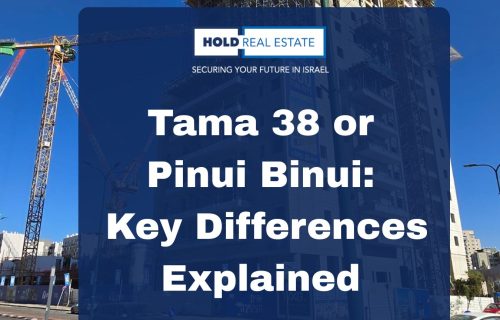Tama 38 vs. Pinui Binui
Understanding the Difference Between Tama 38 and Pinui Binui — What Buyers Need to Know.
Understand the key differences between Tama 38 and Pinui Binui, Israel’s leading urban renewal programs that modernize aging buildings. Learn how Tama 38 strengthens existing structures while Pinui Binui enables full demolition and reconstruction—unlocking earthquake safety, added space, and investment value.
How Israel is Rebuilding Its Future, One Block at a Time
Across Israel, entire neighborhoods are getting a facelift thanks to government-backed urban renewal programs. The two most common, Tama 38 and Pinui Binui, are transforming outdated apartment blocks into safer, more modern homes—while adding much-needed housing to the market. From earthquake-proofing to bigger balconies and underground parking, these initiatives are reshaping skylines and boosting property values. But while the end result may look similar, the path to get there—and the risks involved—can be very different.
Tama 38 Made Simple: Strengthening Homes Without Tearing Them Down
Think of Tama 38 as giving your building a major upgrade—without knocking it down. The developer reinforces the existing structure for safety, often adds a few new floors, and upgrades the plumbing, wiring, and overall design. Most residents can stay put during the work, and the newly built apartments are sold to fund the project. It’s a relatively small-scale renewal that can completely transform an aging building into a safer, more modern home.
Pinui Binui: Out with the Old, In with an Entirely New building.
While Tama 38 upgrades what’s already there, Pinui Binui starts from scratch. Entire buildings—or even whole blocks—are demolished, with residents temporarily relocated during construction. In their place, the developer builds a brand-new, modern complex with more apartments, upgraded infrastructure, and often added perks like green spaces, playgrounds, and commercial areas. When the dust settles, the original residents return to brand-new homes in a completely reimagined neighborhood.
The Main Differences Between Tama 38 and Pinui Binui
1. Scale and impact
Tama 38 focuses on individual buildings. Pinui Binui covers an entire area—sometimes dozens of buildings. Tama 38 often fits into the existing city layout, while Pinui Binui may change the entire face of a neighborhood. If you’re buying, this difference affects the magnitude of the disruption and the extent of the surrounding changes.
2. Structure remains vs. total demolition
With Tama 38, the old building stays and is reinforced. You are still living in the original structure, even if it has been strengthened. In Pinui Binui, the building is completely demolished. You’re buying into a newly built structure, often with underground parking, modern layouts, and new elevators. This is important for buyers looking for new construction rather than upgraded old buildings.
3. Timeline and process
Tama 38 is usually faster. It can take 2–4 years once permits are granted. Pinui Binui takes much longer—often 6–10 years from start to finish, which includes planning. The legal process is more complex and includes negotiations with many residents, planning authorities, and service providers. Buyers must be prepared for a much longer wait with Pinui Binui.
4. Relocation or not?
In Tama 38, residents usually stay in the building while work is done. This can cause noise and disruption. In Pinui Binui, all residents are moved out during construction and receive temporary housing. If you’re buying before the project is complete, this affects how long you’ll wait before moving in.
What Buyers Need to Know About Tama 38.
Understand which stage the project is in
A lot of properties are marketed as “in Tama 38” or “part of a renewal project,” but that doesn’t mean it’s happening soon. Ask if permits have been granted. Ask if the residents have signed agreements with a developer. If it’s only in planning stages, it might not happen at all.
You might be buying into an old building
Even after the project is done, you’re still in the same original structure, just reinforced and improved. The walls, floors, and general layout may still reflect older standards. If you’re expecting a modern building from scratch, you should look elsewhere.
Construction may still be ongoing around you
If you buy before the work is complete, expect noise, dust, and blocked entrances. Even if the unit looks finished, the building may still be under construction. If you’re planning to live there right away, make sure the project is near completion.
Lower cost, but check what’s included
Tama 38 apartments tend to be cheaper than Pinui Binui ones. But compare what you’re getting. Does it come with parking? A balcony? Storage? A better lobby? Don’t assume all Tama 38 projects offer the same upgrades.
What Buyers Need to Know About Pinui Binui
It’s a longer-term investment
If you’re buying in an early stage, you won’t see the apartment for a few years. This is not for buyers who need a place now. It’s more suited for long-term investors or those planning for the future.
You’re buying in a brand-new building
The advantage is clear—you’re getting a brand-new apartment in a fully rebuilt project. Everything from plumbing to electrical systems is modern. Layouts tend to be more spacious, elevators are larger, and underground parking is often included. These features increase comfort and long-term value.
Pay attention to developer credibility
Pinui Binui requires serious money, strong project management, and long-term cooperation with city authorities. Some developers promise a lot but deliver slowly, or not at all. You must check the builder’s track record. How many similar projects have they completed? What stage is this one in?
Know the municipality’s involvement
Not all cities support large-scale renewal equally. Some municipalities are proactive and speed up permits. Others are slow or limit new density. This matters. A project might be ready on paper but stuck for years in the planning office. Buyers should call or check the local city’s published plans.
Shared Considerations for Both Projects
1. Legal checks are important
Before you buy, you must have a real estate lawyer look into the project’s legal status. Has the land been registered properly? Are the permits active? Is the building compliant with planning rules? This applies to both Tama 38 and Pinui Binui.
2. Understand the payment terms
Don’t assume payment is due only on delivery. Some sellers ask for staged payments tied to milestones. Others want full payment upfront. Understand the terms and what happens if construction is delayed.
3. Maintenance and Arnona costs
Both Tama 38 and Pinui Binui apartments often come with higher maintenance fees. More elevators, parking areas, and common spaces mean higher building costs. Arnona may also go up if your unit is larger or in a higher-value zone. Ask to see projected monthly costs.
Making the right choice starts with the right guidance…
Whether you’re drawn to the efficiency of Tama 38 or the full transformation of Pinui Binui, making the right choice starts with the right guidance. Our team specializes in handpicked pre-construction and off-plan projects, built by trusted developers and chosen for their long-term value.
From your first question to the day you receive your keys—and beyond—we’re here to hold your hand through every step. Even from abroad, you can invest in Israel with confidence.
📅 Book a 30-minute virtual consultation today and explore projects tailored to your goals. Your future home in Israel is closer than you think.
Note*The contents of this article are designed to provide the reader with general information and not to serve as legal or professional advice for a particular transaction.
Readers are advised to obtain advice from qualified professionals before entering into any transaction
- Nov 9, 2025
- Aug 12, 2025



